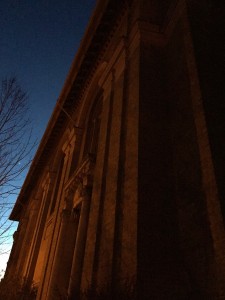Denver: little brown sparrows
 It used to be the Masonic Temple. The imposing stone edifice stood its ground on an angled spit of land at the crooked corner of 32nd and Speer, like a huge ship run aground on a tiny island, looming as night came on. Still, the golden wooden doors looked warm and inviting. Enter here for zazen, the sign read, and it was then I noticed one of the doors barely open, it’s extended deadbolt holding it ajar. The subtlest welcome. I stepped inside.
It used to be the Masonic Temple. The imposing stone edifice stood its ground on an angled spit of land at the crooked corner of 32nd and Speer, like a huge ship run aground on a tiny island, looming as night came on. Still, the golden wooden doors looked warm and inviting. Enter here for zazen, the sign read, and it was then I noticed one of the doors barely open, it’s extended deadbolt holding it ajar. The subtlest welcome. I stepped inside.
Letting the door close softly, I entered the tiny tiled foyer and instant quiet. Shoes lined low shelves along the walls. I saw my face reflected in the glass of the old French doors leading inside, then a small woman in brown Zen robes approaching me from the other side. I smiled as she eased the door open a crack.
“You need to go to an introductory session,” she began abruptly, some East Coast accent adding an edge I did not expect.
“I have done that, though it was a few years ago, at the old location.”
“The old location?”
“Yeah, over on Josephine, I think?”
“A few years ago? That’s a long time ago, that’s like 15 years ago, that’s more than a few years….”
“Are you the one who emailed today?” called a musical voice, softening this meeting. “So sorry, please come in.” My Jersey bouncer looked skeptical but stepped back as a gently smiling middle-aged woman walked my way.
Change happens in stages, sometimes by leaps and bounds, but more often by small steps up the dirt trail and little hops from rock to rock across the water. And so I am not so much beginning as continuing on my way. I took a new job that lets me begin my adventure of leaving home…by coming home to the city I never wanted to leave: Denver. Back here in Denver during the week for work, I added the final requisite irony – I am homeless. I have no official home here currently. So I am staying with generous friends until I land somewhere.
 The Zen Center of Denver is a hundred shades of reassuring old brown, from the golden doors and the tan stone exterior to the dark wooden benches built U-shaped into creamy marble alcoves, the polished French doors to the soft matte of the self-stitched robes worn by the practitioners here. A tiny stone Kuan Yin (called Kannon here) is esconced in a wonderful little wooden cabinet centered above the bench where I sat after I was welcomed in. I had never seen this version, Kuan Yin as a mother with small children reaching up to her in the familiar pose of tired little ones, wanting uppie, uppie mama. It touched me, taking me back decades, to the days when my kids were that little…the days when we lived in Denver. A votive candle flickered beside her, a small glass dish of rice left in offering, a small carnation in a diminutive vase. I had expected a stiff initial response at the door, some slight wariness, formality; what surprised me here was the understated earthiness, the utter normalcy – being talked to in ordinary voices, using completely ordinary phrases. Kuan Yin like a young mother. People came and went, small and brown, a genial group with quiet laughter and smiles filling the antechamber to the zendo as we waited together, like sparrows hopping contentedly on the sidewalk outside, finding sunflower seeds in the cracks.
The Zen Center of Denver is a hundred shades of reassuring old brown, from the golden doors and the tan stone exterior to the dark wooden benches built U-shaped into creamy marble alcoves, the polished French doors to the soft matte of the self-stitched robes worn by the practitioners here. A tiny stone Kuan Yin (called Kannon here) is esconced in a wonderful little wooden cabinet centered above the bench where I sat after I was welcomed in. I had never seen this version, Kuan Yin as a mother with small children reaching up to her in the familiar pose of tired little ones, wanting uppie, uppie mama. It touched me, taking me back decades, to the days when my kids were that little…the days when we lived in Denver. A votive candle flickered beside her, a small glass dish of rice left in offering, a small carnation in a diminutive vase. I had expected a stiff initial response at the door, some slight wariness, formality; what surprised me here was the understated earthiness, the utter normalcy – being talked to in ordinary voices, using completely ordinary phrases. Kuan Yin like a young mother. People came and went, small and brown, a genial group with quiet laughter and smiles filling the antechamber to the zendo as we waited together, like sparrows hopping contentedly on the sidewalk outside, finding sunflower seeds in the cracks.
 When we choose a spiritual practice, we frame it in the language of the practice itself. So Christians talk about letting go of the things of this world, of being called by the Holy Spirit into a deeper relationship with Jesus, looking to the Blessed Trinity of Father / Son / Holy Ghost, while Buddhists talk about letting go of attachments and taking refuge in the Buddha, the Dharma, and the Sangha, the Three Jewels. Sangha is the Buddhist equivalent of the Christian congregation, the community of saints, which is really the community of sinners who kept trying, really hard. Is there a difference then ultimately, between sinners and saints? Between me, boddhisattvas (those saints of the Buddhist tradition), and the Buddha? The Buddha being just a guy named Siddhartha, similar to a guy named Jesus. Real people, trying to find meaning as a refuge in their real lives, great teachers to other people seeking meaning, seeking refuge, safe shelter.
When we choose a spiritual practice, we frame it in the language of the practice itself. So Christians talk about letting go of the things of this world, of being called by the Holy Spirit into a deeper relationship with Jesus, looking to the Blessed Trinity of Father / Son / Holy Ghost, while Buddhists talk about letting go of attachments and taking refuge in the Buddha, the Dharma, and the Sangha, the Three Jewels. Sangha is the Buddhist equivalent of the Christian congregation, the community of saints, which is really the community of sinners who kept trying, really hard. Is there a difference then ultimately, between sinners and saints? Between me, boddhisattvas (those saints of the Buddhist tradition), and the Buddha? The Buddha being just a guy named Siddhartha, similar to a guy named Jesus. Real people, trying to find meaning as a refuge in their real lives, great teachers to other people seeking meaning, seeking refuge, safe shelter.
Paramita is a Sanskrit word used in Buddhism to describe where we hope to land, that refuge of meaning. It means perfection, literally “having reached the other shore” – our destination. The other shore is usually interpreted as enlightenment. The six paramitas are the parts of the boat that, used together, can carry us across the endless ocean waves of self-generated suffering to a groundedness that brings more peace. Less tempest of our drama, more temperance of the dharma, so to speak, dharma being how things really are, whether we like it or not. The paramitas can be summarized as generosity, moral compassion, patient endurance, courageous effort, focused concentration, and wisdom. To me, these are the sails and oars that we practice using, gaining skill to sail the boat toward that calm, distant shore just over the horizon.
We sat zazen on brown cushions, silent and unmoving, and I felt…comraderie. Traffic roared by outside the temple, ebbing and flowing with the changing stoplights, and the sound came like ocean waves breaking over us, breaking against our great ship of stone and solid intention as we breathed, together.
This kind of fellowship, it is enough, for now. I do not seek enlightenment. I seek a ship, and a wide, open horizon. My home for now is this sangha, here with these other little sparrows who fluttered aboard seeking refuge and now find ourselves hopping on the deck among the ropes and tackle, hunting around for what might feed and sustain us, some small seed hidden in the cracks. Most of us don’t even realize we are on a ship bound for another shore.

